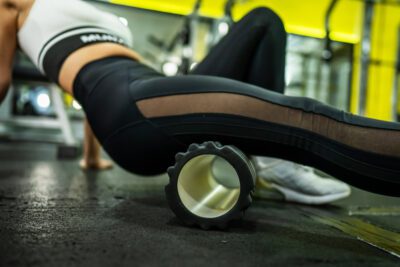Do you love working out? It could be a habit you picked on your weight loss journey or even a hobby. Have you just started working out? One of the things you’ve likely experienced or are likely to experience is muscle soreness after a workout.
It’s characterized by pain and stiffness in your muscles. Muscle soreness is a result of lactic acid buildup when working out. Did you know muscle soreness is something you can reduce before and after working out? How?
Here are tips to guide you:

1. Practice Red Light Therapy
Red light therapy is a treatment that uses natural wavelengths of red light to address various issues in the body. You require to administer it through the skin where it’ll penetrate the body.
The benefits of red light therapy are creating more energy in the body’s cells, enhancing their performance, and reducing muscle soreness after a workout.
Administering red light therapy requires buying the red-light device. It can be handheld, which targets specific areas, or one that targets the entire body. It’s best to seek the latter in this case.
With the device, place it 6 to 12 inches from your skin. It prevents overheating and damage to the skin.
Health experts recommend that you do the following:
- Administer the therapy for a maximum of 20 minutes per session.
- Reduce the sessions to three to five times a week.
- Use FDA-approved red light devices.
- Wear eye protection during the procedure to prevent eye damage.
2. Focus On Your Body Posture
Body posture refers to how your body positions itself as you work out. Yes, there are bad and good postures. Bad posture increases the possibility of injuries.
Good posture ensures you engage the right muscles during a workout. It prevents muscle exertion in the process.
What’s good and bad posture? It all depends on the exercise you’re performing. If you’re cycling, have your shoulders back with your chest elevated. While running, avoid hunching your neck. Where you’re lifting weights, always engage your core.
It’d help to practice beforehand to ensure you have the right posture in all your exercises. Your trainer can guide you in maintaining the right form as you work out.

3. Always Warm Up And Stretch
Warming up entails stretching your body before working out. The aim is to prepare it for what’s to come. The right warm-up increases blood flow in the body. The result is oxygen reaching your muscles, which helps them relax. Relaxed muscles will move easily, preventing soreness.
There are various ways to warm up. It often depends on the length of your planned workout, your fitness level, and the exercise you’re doing. It’s always advisable to warm up the muscles you’ll use for a given workout.
Taking a brisk walk or jogging is ideal if you plan to run. Stretching your quads and glutes is best for squats, among other exercises. Alternatively, you can do the easier version of your planned workout. It prepares your muscles as well as you, psychologically.
Stretching is best done after a workout, although you can still do it before. It helps your muscles to relax after all the strain and engagement. As with warming up, stretch the muscles you’ve engaged when working out.
Fitness experts advise having your warm-ups and stretches for approximately 5 to 10 minutes maximum.
4. Stay Hydrated
Working out involves a lot of sweating. Sweating reduces the amount of water in your body, hence the need to stay hydrated.
The need for hydration increases after working out. Drinking water after a workout flushes out lactic acid buildup in your muscles. This acid is known to increase muscle soreness. It’d help to drink at least eight glasses of water daily as the bare minimum. However, you can increase this based on your needs.
Today, there are many ways to take water. These techniques increase the enjoyment of hydrating, prompting you to take more and more. Some will add cucumber, lemon, and orange wedges to their drinks.
To reduce muscle soreness after a workout, it’s best to add lemon to your water. It’ll help reduce lactic acid buildup in your muscles, even as it replaces lost water.
5. Use A Foam Roller
A foam roller is a cylinder-shaped dense foam used for Self-Myofascial Release (SMR). SMR refers to self-massage. Foam rolling relieves muscle tightness by increasing blood flow in the body. It’ll break down any muscle layering that results in pain.
The best way to foam roll is to apply light to moderate pressure on your aching muscles. Do this by focusing on the body weight you exert on the foam. You can use your arms for support while aiming for light pressure.
Fitness gurus advise foam rolling for 20 minutes immediately after working out. Do the same after 24 to 48 hours for maximum effectiveness. Also, you should purchase the right foam roller. The choice depends on your needs. Some are smooth, with others being textured and having bumps. The latter is best for deep tissue massage while the former is good for light massaging.
It’s important to pinpoint that health experts don’t recommend foam rolling for serious injuries like torn muscles. Also, avoid foam rolling small muscles and joints like the ankle and elbow.
6. Take A Break
Yes, you’ve committed to working out daily to achieve certain fitness or weight loss goals. As the adage goes, too much of something is poisonous. This phrase greatly applies to working out.
Constant working out exerts a lot of pressure on your muscles and joints. In some cases, you can easily manage the soreness with a few exercises here and there. What if there’s no progress with muscle relief even after all the aftercare? It’s best to take a break.
Taking a break means taking a day or two off from working out. The break gives your muscles and body time to repair, recover, and recharge.
As you take rest days, knowing when to take them is important. You don’t want to have them every other day. They’ll defeat your purpose of losing weight. It’d help to pick a day of the week that’ll be your rest day. Doing so gives you a balance between getting the results and taking care of your well-being.
Conclusion
Preventing and reducing muscle soreness after a workout is something you can easily achieve. With the right insight, as this article gives, you’ll have an easy time as you enjoy your fitness journey. Therefore, it’s best to implement these tips to ensure you care for your body as you work out.